Role of the 5-HT₂A receptor in the locomotor hyperactivity produced by phenylalkylamine hallucinogens in mice
- PMID: 23376711
- PMCID: PMC3934507
- DOI: 10.1016/j.neuropharm.2013.01.014
Role of the 5-HT₂A receptor in the locomotor hyperactivity produced by phenylalkylamine hallucinogens in mice
Abstract
The 5-HT₂A receptor mediates the effects of serotonergic hallucinogens and may play a role in the pathophysiology of certain psychiatric disorders, including schizophrenia. Given these findings, there is a need for animal models to assess the behavioral effects of 5-HT₂A receptor activation. Our previous studies demonstrated that the phenylalkylamine hallucinogen and 5-HT₂A/₂C agonist 2,5-dimethoxy-4-iodoamphetamine (DOI) produces dose-dependent effects on locomotor activity in C57BL/6J mice, increasing activity at low to moderate doses and reducing activity at high doses. DOI did not increase locomotor activity in 5-HT₂A knockout mice, indicating the effect is a consequence of 5-HT₂A receptor activation. Here, we tested a series of phenylalkylamine hallucinogens in C57BL/6J mice using the Behavioral Pattern Monitor (BPM) to determine whether these compounds increase locomotor activity by activating the 5-HT₂A receptor. Low doses of mescaline, 2,5-dimethoxy-4-ethylamphetamine (DOET), 2,5-dimethoxy-4-propylamphetamine (DOPR), 2,4,5-trimethoxyamphetamine (TMA-2), and the conformationally restricted phenethylamine (4-bromo-3,6-dimethoxybenzocyclobuten-1-yl)methylamine (TCB-2) increased locomotor activity. By contrast, the non-hallucinogenic phenylalkylamine 2,5-dimethoxy-4-tert-butylamphetamine (DOTB) did not alter locomotor activity at any dose tested (0.1-10 mg/kg i.p.). The selective 5-HT₂A antagonist M100907 blocked the locomotor hyperactivity induced by mescaline and TCB-2. Similarly, mescaline and TCB-2 did not increase locomotor activity in 5-HT₂A knockout mice. These results confirm that phenylalkylamine hallucinogens increase locomotor activity in mice and demonstrate that this effect is mediated by 5-HT₂A receptor activation. Thus, locomotor hyperactivity in mice can be used to assess phenylalkylamines for 5-HT₂A agonist activity and hallucinogen-like behavioral effects. These studies provide additional support for the link between 5-HT₂A activation and hallucinogenesis.
Copyright © 2013 Elsevier Ltd. All rights reserved.
Figures


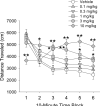


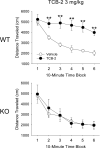
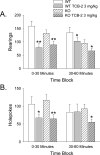
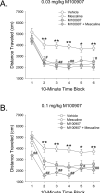
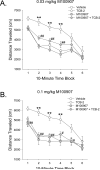
Similar articles
-
5-hydroxytryptamine 2C/1A receptors modulate the biphasic dose response of the head twitch response and locomotor activity induced by DOM in mice.Psychopharmacology (Berl). 2024 Nov;241(11):2315-2330. doi: 10.1007/s00213-024-06635-4. Epub 2024 Jun 25. Psychopharmacology (Berl). 2024. PMID: 38916640
-
Interactive effects of mGlu5 and 5-HT2A receptors on locomotor activity in mice.Psychopharmacology (Berl). 2011 May;215(1):81-92. doi: 10.1007/s00213-010-2115-1. Epub 2010 Dec 10. Psychopharmacology (Berl). 2011. PMID: 21153406 Free PMC article.
-
Hallucinogen-like effects of 2-([2-(4-cyano-2,5-dimethoxyphenyl) ethylamino]methyl)phenol (25CN-NBOH), a novel N-benzylphenethylamine with 100-fold selectivity for 5-HT₂A receptors, in mice.Psychopharmacology (Berl). 2015 Mar;232(6):1039-47. doi: 10.1007/s00213-014-3739-3. Epub 2014 Sep 17. Psychopharmacology (Berl). 2015. PMID: 25224567 Free PMC article.
-
Pharmacology and Toxicology of N-Benzylphenethylamine ("NBOMe") Hallucinogens.Curr Top Behav Neurosci. 2017;32:283-311. doi: 10.1007/7854_2016_64. Curr Top Behav Neurosci. 2017. PMID: 28097528 Review.
-
TCB-2 [(7R)-3-bromo-2, 5-dimethoxy-bicyclo[4.2.0]octa-1,3,5-trien-7-yl]methanamine]: A hallucinogenic drug, a selective 5-HT2A receptor pharmacological tool, or none of the above?Neuropharmacology. 2018 Nov;142:20-29. doi: 10.1016/j.neuropharm.2017.10.004. Epub 2017 Oct 4. Neuropharmacology. 2018. PMID: 28987938 Review.
Cited by
-
The serotonin 2A receptor agonist TCB-2 attenuates heavy alcohol drinking and alcohol-induced midbrain inhibitory plasticity.Addict Biol. 2022 Mar;27(2):e13147. doi: 10.1111/adb.13147. Addict Biol. 2022. PMID: 35229942 Free PMC article.
-
The Bright Side of Psychedelics: Latest Advances and Challenges in Neuropharmacology.Int J Mol Sci. 2023 Jan 10;24(2):1329. doi: 10.3390/ijms24021329. Int J Mol Sci. 2023. PMID: 36674849 Free PMC article. Review.
-
Psychedelics.Pharmacol Rev. 2016 Apr;68(2):264-355. doi: 10.1124/pr.115.011478. Pharmacol Rev. 2016. PMID: 26841800 Free PMC article. Review.
-
An Overview on the Hallucinogenic Peyote and Its Alkaloid Mescaline: The Importance of Context, Ceremony and Culture.Molecules. 2023 Dec 5;28(24):7942. doi: 10.3390/molecules28247942. Molecules. 2023. PMID: 38138432 Free PMC article. Review.
-
Sex-specific effects of psychedelic drug exposure on central amygdala reactivity and behavioral responding.Transl Psychiatry. 2023 Apr 8;13(1):119. doi: 10.1038/s41398-023-02414-5. Transl Psychiatry. 2023. PMID: 37031219 Free PMC article.
References
-
- Abdolmaleky HM, Yaqubi S, Papageorgis P, Lambert AW, Ozturk S, Sivaraman V, Thiagalingam S. Epigenetic dysregulation of HTR2A in the brain of patients with schizophrenia and bipolar disorder. Schizophr. Res. 2011;129:183–190. - PubMed
-
- Adams L, Geyer MA. Effects of DOM and DMT in a proposed animal model of hallucinogenic activity. Prog. Neuropsychopharmacol. Biol. Psychiatry. 1985;9:121–132. - PubMed
-
- Arranz MJ, Munro J, Owen MJ, Spurlock G, Sham PC, Zhao J, Kirov G, Collier DA, Kerwin RW. Evidence for association between polymorphisms in the promoter and coding regions of the 5-HT2A receptor gene and response to clozapine. Mol. Psychiatry. 1998;3:61–66. - PubMed
-
- Arranz B, Rosel P, San L, Ramírez N, Dueñas RM, Salavert J, Centeno M, del Moral E. Low baseline serotonin-2A receptors predict clinical response to olanzapine in first-episode schizophrenia patients. Psychiatry Res. 2007;153:103–109. - PubMed
-
- Berg KA, Maayani S, Goldfarb J, Scaramellini C, Leff P, Clarke WP. Effector pathway-dependent relative efficacy at serotonin type 2A and 2C receptors: evidence for agonist-directed trafficking of receptor stimulus. Mol. Pharmacol. 1998;54:94–104. - PubMed
Publication types
MeSH terms
Substances
Grants and funding
LinkOut - more resources
Full Text Sources
Other Literature Sources

